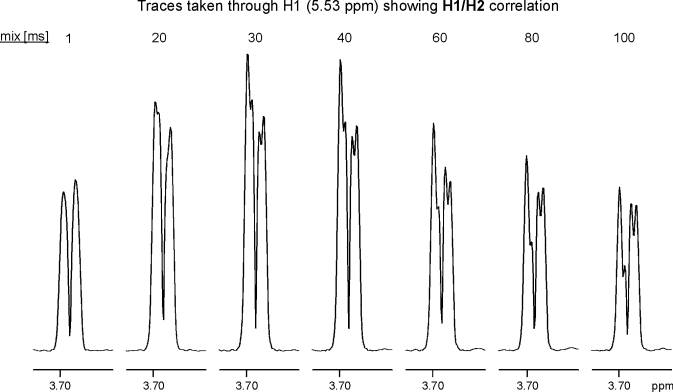|
|
s400 available via the on-line reservation system for overnight and weekend bookings |
|
|
FAQ 2001-06.1: what is the effect of different mixing times in GTOCSY and what is it useful for? |
Department of Chemistry,
University of Alberta December 2001
NMR News 2001-06
News and tips for users of the Varian NMR systems in the
Department
Editor: Albin.Otter@ualberta.ca
http://nmr.chem.ualberta.ca
There are no fixed publishing dates for this newsletter; its appearance solely depends on whether there is a need to present information to the users of the spectrometers or not.
Other content of this NMR News is no longer meaningful and has been removed April 2010.
Contents
|
|
s400
available via the on-line reservation system for overnight and weekend
bookings |
FAQ 2001-06.1: what is the
effect of different mixing times in GTOCSY and what is it useful for?
Added 2008-03-05:
effect of mixing time in
CSSF 1D-TOCSY.
 |
GTOCSY (Total correlation spectroscopy, the G simply indicates that it is recorded with gradients) is one of the most powerful homonuclear 2D techniques to separate overlapping signals in oligomers such as peptides and carbohydrates. Applied properly, it can achieve far more than a GCOSY. For a review of the differences between GCOSY and GTOCSY see FAQ 98-09.1 and for help with the selection of the mixing time (parameter mix) click here. The mixing time is important to achieve the desired result. This example of a trisaccharide, containing three a-Glc moieties, of which only one is drawn, demonstrates that the mixing time can also be used as a tool to distinguish resonances within the same unit and not only to separate entire "building blocks" (sugar rings in this case) of the oligomer. |
|
|
The contour plots on the left show the result of a series of GTOCSY experiments carried out at mixing times between "0" an 100 ms (hardware limitations require 1 instead of 0 ms). Clearly, at "0" or very short mixing times, the GTOCSY is no different than the GCOSY: starting from H1 at 5.53 pm, only one, namely the H1/H2, correlation is observed. When mix is increased gradually, more and more correlations appear (e.g. H5 appears at 60 and becomes a useful signal at 80 ms). The evolution of these peaks as a function of increasing mixing time can best be seen in the two cross-section plots at the bottom. The H1-H2 correlation is present right from the start, increasing in intensity up to 30 ms then decreases while the H1/H4 correlation is not visible up to 20 ms (max. at 80 ms). In other words, GTOCSY experiments run with different mixing times can be used to distinguish signals that otherwise would be hard to assign. If a GCOSY analysis leads to overlap problems when crossing the diagonal, then GTOCSY is the only way to distinguish. In this example, H3 and H4 are both triplets and as such ambiguous. If only the 100 ms data were available, H3 vs. H4 would be a pure guessing game but with the delayed appearance of H4 relative to H3 the distinction is easy. Please also note how the coupling patterns are visible, although distorted, in the cross-peaks: H2 shows the typical large/small J pattern while H3 and H4 are large/large J (triplet) patterns. This is typical in homonuclear 2D experiments if acquired with sufficient digitization. |

